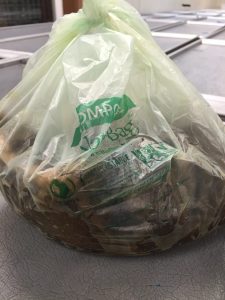Source: blog.alaskaair.com
Published: May 5, 2016
By Marianne Lindsey, Staff Writer

Alaska Airlines serves up 37,000 cups of coffee a day on its more than 900 daily flights, brewed using more than 250,000 pounds of Starbucks coffee each year. Ensuring that those grounds go back into the earth and not into the trash is the goal of a new composting effort at Alaska Airlines.
Gardeners know that coffee grounds make for great plant food and that they are environmentally friendly. But gathering the used grounds and filters on more than 500 flights a day is a challenge, says Alaska Airlines Food and Beverage Specialist Kathy Hues.
One of the problems is getting past the ewww factor.
Wet coffee grounds and filters, once they sit awhile, become cold, clammy and—well, yucky as they start to decompose. Providing flight attendants with compostable ‘bio bags’ and gloves, helped make it easier.
The grounds-for-change effort started with just 25 flight attendants who tested the bags. It eventually blossomed as the airline’s catering facilities and airports began to add composting sites. The sites collect the coffee grounds bagged by flight attendants, mixes them with other kitchen scraps, and the whole mess is processed into compost.

Today Alaska composts at 12 flight kitchens, including its largest at Seattle-Tacoma International Airport and in-flight composting of coffee grounds is now standard practice on all Alaska flights. Colleagues at Alaska’s regional carrier Horizon Air, where coffee is brewed before take-off, already compost over 14 tons of coffee grounds each year.
But coffee is just the first sip. Hues says 30 percent of in-flight waste is compostable, so she’s continuing to look for new ways to perk up composting efforts.
A pilot program for composting at one of Alaska’s Sea-Tac-area office buildings last year served to educate employees and change habits. An audit of the effort (literally dumping out the trash bins and sorting through compostable items that didn’t go into the right bin) showed a savings of more than 300 gallons of waste per week and reduced hauling costs. Alaska will bring composting to more of its office buildings this year.
“Making it easy is key,” said Hues, who can’t wait to get her hands into more office trash bins to see how her coworkers are doing. With gloves on of course.
It’s easy to make your own coffee ground compost:
- Start by having a receptacle near your coffee maker, where it’s handy to put spent grounds and filters. Just keep filling it up, until it’s full, then take it outside to the compost bin.
- Make a do-it-yourself compost bin. Use an old trash can with the bottom cut out, or make a crafty box out of recycled wood. It just needs to be open on the top and the bottom. Put it right into the dirt.
- Put your coffee grounds and filters in the bin. Now here’s the science. Coffee grounds are rich in nitrogen, which makes them a “green” composting material. Green materials must be balanced with carbon-rich or “brown” materials. So add some dried leaves, or shredded paper. You can toss in apple cores, grass clippings and food scraps too!
- Cover the bin. If you’re in an area that gets a lot of rain, stir the compost with a shovel often. In a few months, the material will begin breaking down. Use it in your garden or around you plants to feed them all year long.
Composting is one of a series of accomplishments highlighted in Alaska Air Group’s newly-released sustainability report, which summarizes the company’s progress on environmental, social and economic goals. The complete report is available at www.alaskaair.com/sustainability.
